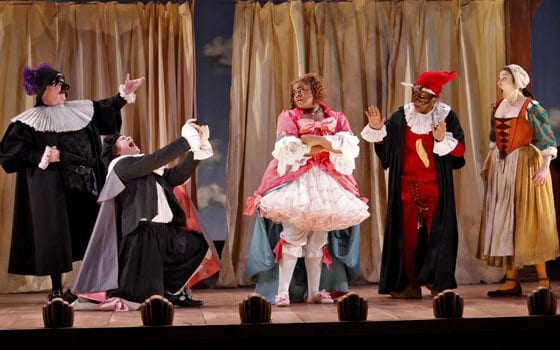
When Carlo Goldoni crafted his 18th-century masterpiece, “The Servant of Two Masters,” he borrowed from a theatrical tradition that used gags not only to entertain but also to expose injustice, hypocrisy and class pretensions.
The exuberant Yale Repertory Theatre production of the play that was at the Paramount Center Mainstage through Sunday, a presentation of ArtsEmerson: The World on Stage, was content to jab the funny bone and offer a valentine to the joys of theater.
Director Christopher Bayes and actor Steven Epp, who plays the central character, Truffaldino, are alumni of the former Theatre de la Jeune Lune in Minneapolis, a company steeped in old-school techniques of full-body physical comedy.
The production also stirs doses of Yiddish theater and British music hall routines into its savory melting pot of comic traditions. Set designer Katherine Akiko Day evokes the hardscrabble era of old-time theater troupes by draping a soiled curtain over wooden planks to create a stage. Framing it is a worn but romantic arch of rosettes and fractured bricks.
The play starts with a brief prelude: Entering a darkened stage, two performers shine flashlights into the audience as they stumble into what they describe in Italian as a dark, dirty old theater. Opening a battered trunk, they release a cloud of stardust.
The lights go up and a backdrop of blue sky and white clouds unfurls over a dollhouse-sized townscape. Set in Goldini’s hometown, Venice, the scene opens on the betrothal of two lovers, Clarice and Silvio. Ruckus ensues as they learn that Clarice’s original fiancé, Federigo, who was killed in a duel, is at the door to claim her hand and dowry (Actually it is the dead man’s sister, Beatrice, in disguise. She seeks her lover Florindo, the duelist who killed her brother, we know not why).
Three couples find their way to love after whirling through a cyclone of mistaken identities, mix-ups, deceit and double-dealing. At its center is the crafty Truffaldino, who schemes to double his meals and pay by hiring himself out to both Federigo (Beatrice) and Florindo, who arrives in search of Beatrice.
Music is a huge part of the fun. Outfitted in peasant costumes and feathered caps are two onstage musicians, Carolyn Boulay on fiddle and Aaron Halva on drums and accordion. Composed by Halva and Christopher Curtis, the score mingles Italian pop and folk songs with wafts of RandB, gospel, hip-hop and light opera, including a few charming arias and a lovely three-way chorus by the women in the cast.
Period costumes by Valérie Thérèse Bart evoke the gallery of stock characters Goldini drew from in his play. A character based on a clown, Truffaldino is sheathed in a classic diamond-patterned Harlequin bodysuit. The courtiers are cloaked in black capes, jackets and garters and the servants wear beige peasant attire.
The women are terrific: Sarah Agnew, a cool, calm Beatrice, is fun to watch as she both stokes and stays above the folly around her. Adina Verson’s Clarice is a sweet hysteric. Liz Wisan’s Smeraldina, her devoted and down-to-earth servant, is adorable in her love scenes with Truffaldino and heart felt soliloquies with the audience.
Each character has a signature tic that takes on a life of its own. Every time Florindo, a hilarious Randy Reyes, tosses his extravagant mane, a collective swoon ripples through the onlookers. When Beatrice stamps her foot to seal a command, it sets off a cascade of sound effects, such as crashing pots.
More kin to the Three Stooges than the Marx Brothers, all this is fun up to a point. But you may side with Truffaldino when, near the end of the two-and-a-half hour production, he asks, “Will this play ever end?”
The ebullient, 11-person cast gives its all to the production, including its bits of improvisational surprise. As it did in Goldini’s time, the play makes room for local humor. Fodder for its here-and-now jokes includes the Patriots, mullets, Scott Brown and the MBTA. When, by mistake, Truffaldino pulls a switch and plunges the theater into darkness, he asks, “Did I get on the Green Line?”
Amid the humor is a sweet hint that beyond his chronic craving for food, Truffaldino also hungers for happiness. Smitten by Smeraldina, he shyly woos her, and declares, “You’d satisfy me more than all the food in the world.”
In the final scene, Smeraldina and Truffaldino evaporate into dancing fireflies and a crescent moon rises, a tribute to the disbanded Theatre de la Jeune Lune and to romance.






